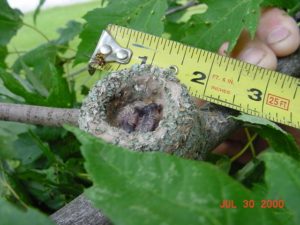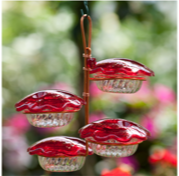6oz Hummingbird Item #010
Hummingbird Mixture
1 Part white sugar with 4 part water and boil for 1 or 2 minutes.
Example: 1 cup Sugar and 4 cups water
You should thoroughly clean the feeders and replace the solution every 3 to 4 days.
Unused mixture can be stored in the refrigerator for up to a week. Cane sugar is highly recommended, although beet sugar is okay. Do not use any other sugar — not turbinado or brown sugar etc — and never use honey or artificial sweeteners. Spring water is preferred, but most tap water is acceptable.
Hang the feeder approximately 5 feet above the ground, Make sure there is no foliage underneath that would encourage unwelcome guests, like mice, squirrels and even cats, to feed on the sugar water. If you wish to hang multiple hummingbird feeders, locate the feeders at least 10 to 12 feet apart.
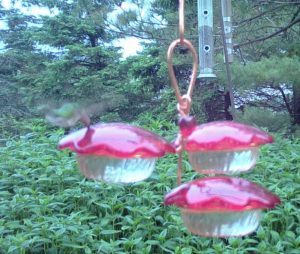
Arrive: up by mid-March to attract early migrants–a week or two later in the northern U.S. and Canada, a week or two earlier along the Gulf Coast (see average arrival dates at Migration Map). DON’T wait until you see your first Ruby-throated Hummingbird of the spring, which may be well after the first ones arrive.
And there are many documented reports of hummingbirds that survive the snow and freezing temperatures–as long as they have food sources.
Current migration map for Hummingbirds visit:
www.reconnectwithnature.org search: Hummingbird Migration
Hummingbirds are birds from the Americas that constitute the family Trochilidae. They are among the smallest of birds, most species measuring 7.5–13 cm in length. Wikipedia
Lifespan: 3 – 5 years
Scientific name: Trochilidae
Speed: 49 mph (Maximum, Diving)
Mass: Bee hummingbird: 0.056 – 0.071 oz
Rank: Family
Did you know: Hummingbirds spend an average of 10–15% of their time feeding and 75–80% sitting and digesting.
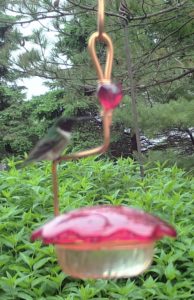
Flight: A hummingbird’s flight is its most unusual behavior… At times, hummingbirds can even fly upside down! Ruby-throated hummingbird flaps its wings up to 70 times per second.
The Giant Hummingbird beats its wings 10-15 times per second.
This incredible flying ability makes hummingbirds one of the most fascinating birds to watch. … Hummingbirds almost never stop moving, and they spend nearly all of their time in the air. They fly in a direct path unless they are making a male display flight. …Their legs are so small and weak, they typically can’t walk at all. But in the air, they’re masters.
Fly at night: In some locations–especially if there is artificial lighting such as security or porch light–hummingbirds may feed well into the night, usually during warmer weather. Hummingbirds DO fly at night, but almost always this happens during migration.
Sound: Their wings make a loud buzz at the bottom of the arc.

Feeding: Hummingbirds eat almost exclusively nectar and insects such as gnats and spiders.
Hummingbirds are BIG eaters. No animal on earth has a faster metabolism-roughly 100 times that of an elephant. Hummingbirds burn food so fast they often eat 1.5 to 3 times their body weight in food per day! In order to gather enough nectar, hummingbirds must visit hundreds of flowers every day.
Heart Beat/Organs: Their hearts can beat as fast as 1,260 beats per minute, when resting, heart rate reaches 250 beats per minute, which is the rate measured in a Blue-throated Hummingbird, or as slow as 50-180 beats per minute on a cold night when they experience torpor, a hibernation-like state. By doing so, a torpid hummingbird consumes up to 50 times less energy.
Hummingbirds do not …have a gall bladder. A Ruby-throated Hummingbird at rest breathes about 250 times per minute. Air enters the respiratory system through nostrils at the base of the bill and enters the small paired lungs.
Habitat: The first step toward attracting nesting hummingbirds is to be sure your yard is hummingbird-friendly. To do so, your yard should include: Food: Nectar-producing flowers and hummingbird feeders are great options, but also avoid spraying for spiders or other insects.
To maintain a healthy ecosystem in your yard:
- Eliminate pesticides…
- Make sure your yard contains insect-pollinated flowers as well as hummingbird-pollinated plants.
- Hang a basket with overripe fruit or banana peels close to a hummingbird feeder to attract tiny fruit flies.
- Use native plants.
Color: Hummingbirds are attracted to brightly colored flowers, including yellow, orange, pink and purple, but they are attracted to red more than any other color, as red seems to be an indicator of food to these small birds. Planting a variety of brightly colored flowers, and including red, helps attract hummingbirds.
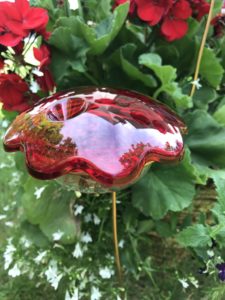
Brightly–colored flowers that are tubular hold the most nectar, and are particularly attractive to hummingbirds. These include perennials such as bee balms, columbines, daylilies, and lupines; biennials such as foxgloves and hollyhocks; and many annuals, including cleomes, impatiens, and petunias.
Sleep: Hummingbirds sleep where they can perch on a tree branch at nighttime, which is when they enter a torpor state of temporary hibernation.
Mate for life: No. They don’t even stay together to raise the babies. The female does ALL the nest building, incubating, and caring for the babies herself, and a male hummer will mate with any females that he can attract to his territory. These are NOT romantic birds.
Speed: Hummingbirds can fly as fast as 60 miles per hour during courtship displays, but their average flying speed is closer to 30 miles per hour.
Nest: Hummingbirds build velvety, compact cups with spongy floors and elastic sides that stretch as the young grow. They weave together twigs, plant fibers, and bits of leaves, and use spider silk as threads to bind their nests together and anchor them to the foundation. Hummingbird eggs are about the size of navy beans. Male hummingbirds provide no care to their offspring. In fact, after they mate with the female, they simply move on and may never see her again. However, hummingbird females make do. … After mating, the female lays two tiny eggs.
Baby Hummingbird eats: In addition to nectar, hummingbirds eat insects to fulfill their need for protein. Hummingbirds must eat often and will die within 4 hours of no food source.
Depart: Most Ruby-throated Hummingbirds winter between southern Mexico and northern Panama. Since hummingbirds lead solitary lives and neither live nor migrate in flocks, an individual bird may spend the winter anywhere in this range where the habitat is favorable, but probably returns to the same location each winter. Hummingbird Myth: Hummingbirds hitch rides on the backs of geese as they migrate south. Hummingbird Fact: This legend is entertaining, but untrue. Hummingbirds and Canada geese migrate at different times and to different destinations. Fact: Most, but not all, hummingbirds migrate south for winter. The ruby-throated hummingbird flies 500 miles nonstop across the Gulf of Mexico during both its spring and fall migrations. It is a myth, however, that these tiny birds “ride” on the back of other birds during migration – they do this distance completely on their own.
12oz Hummingbird Item #012



